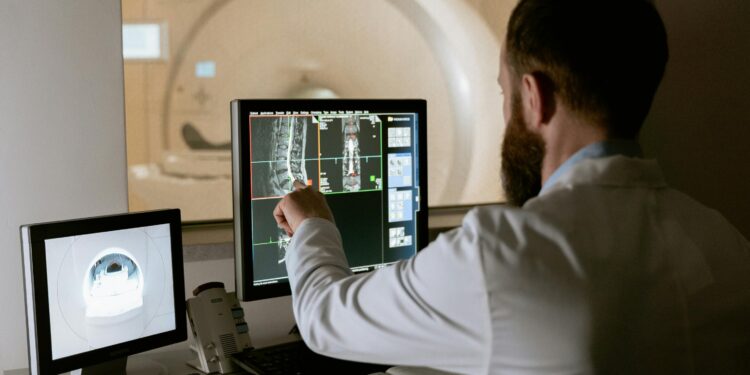Credit: MART PRODUCTION by Pexels
UCLA researchers have developed a fast-learning deep learning framework to automatically analyze and diagnose MRIs and other 3D medical images with accuracy matching that of medical specialists in a fraction of the time. An article describing the work and capabilities of the system is published in Natural biomedical engineering.
Unlike the few other models under development for analyzing 3D images, the new framework exhibits high adaptability across a variety of imaging modalities. Developers studied it with 3D retinal scans (optical coherence tomography) for disease risk biomarkers, ultrasound videos for heart function, 3D MRI scans for assessment of liver disease severity and a 3D scanner for screening thoracic nodules. They say this provides a basis that could also prove useful in many other clinical settings, and studies are planned.
Artificial neural networks train themselves by performing many repeated calculations and examining extremely large data sets reviewed and labeled by clinical experts. Unlike standard 2D images that show length and width, 3D imaging technologies add depth, and these “volumetric” or 3D images require more time, skill and attention to be interpreted by an expert.
For example, a 3D retinal imaging scan may be comprised of nearly 100 2D images, requiring minutes of careful inspection by a highly trained clinical specialist to detect delicate biomarkers of disease, such as measuring blood volume. an anatomical swelling.
“While there are many AI (artificial intelligence) methods for analyzing 2D biomedical imaging data, the compilation and annotation of large volumetric data sets that would be required for standard 3D models to exhaust the full potential “AI are infeasible with standard resources, but their training efforts typically focus on a single imaging modality and a specific organ or disease,” said researcher Oren Avram, Ph.D. postdoctoral fellow at UCLA Computational Medicine and co-first author of the paper.
The UCLA computer model, called SLIViT, for SLice Integration by Vision Transformer, consists of a unique combination of two artificial intelligence components and a unique learning approach that researchers say allows it to predict with Accurate disease risk factors from medical analyzes across multiple volumetric modalities with moderately sized labeled datasets.
“SLIViT overcomes the bottleneck of training dataset size by leveraging prior ‘medical knowledge’ from the more accessible 2D domain,” said Berkin Durmus, a UCLA Ph.D. student and co-first author of the article. He and Avram are affiliated researchers with the Henry Samueli School of Engineering at UCLA and other UCLA schools and departments.
“We show that SLIViT, although a generic model, consistently achieves significantly better performance than state-of-the-art domain-specific models. It has potential for clinical applicability, matching the precision of manual expertise of clinical specialists while reducing time by a factor of 5,000. And unlike other methods, SLIViT is flexible and robust enough to work with clinical data sets that are not always in perfect condition,” Durmus said.
Avram said SLIViT’s automated annotation could benefit patients and clinicians by improving the efficiency and speed of diagnosis, and that it advances and accelerates medical research by reducing the cost and time to acquire data. data. Additionally, it provides a base model to accelerate the development of future predictive models.
“What excited me most was the remarkable performance of SLIViT in real-world conditions, especially with small training datasets,” said SriniVas R. Sadda, MD, professor of ophthalmology. at UCLA Health and director of artificial intelligence and imaging research at Doheny. Eye Institute.
“SLIViT thrives with only hundreds, not thousands, of training samples for some tasks, giving it a substantial advantage over other standard 3D-based methods in almost all practical cases related to 3D biomedical imaging annotation.”
Eran Halperin, Ph.D., professor of computer science in the Henry Samueli School of Engineering and Computational Medicine at the David Geffen School of Medicine at UCLA, said that even if financial resources were unlimited, the Ongoing research will always face challenges posed by limited resources. training datasets – in clinical settings, for example, or when examining emerging biomedical imaging modalities.
“When a new disease-related risk factor is identified, training specialists can take months to accurately annotate the new factor on a large scale in biomedical images,” he said.
“But with a relatively small dataset, which a single trained clinician can annotate in just a few days, SLIViT can significantly accelerate the annotation process for many other unannotated volumes, achieving performance levels comparable to those of clinical specialists.”
Halperin and Sadda are co-senior authors of the paper.
In addition to expanding their studies to include additional treatment modalities, the researchers plan to investigate how SLIViT can be leveraged for predictive disease prediction to improve early diagnosis and treatment planning. To promote its clinical applicability, they will also explore ways to ensure that systematic biases in AI models do not contribute to health disparities.
More information:
Accurate prediction of disease risk factors from volumetric medical scans by a deep vision model pre-trained with 2D scans, Natural biomedical engineering (2024). DOI: 10.1038/s41551-024-01257-9
Provided by University of California, Los Angeles
Quote: New AI model effectively achieves clinical expert-level accuracy in complex medical analyzes (October 1, 2024) retrieved October 1, 2024 from
This document is subject to copyright. Except for fair use for private study or research purposes, no part may be reproduced without written permission. The content is provided for informational purposes only.



